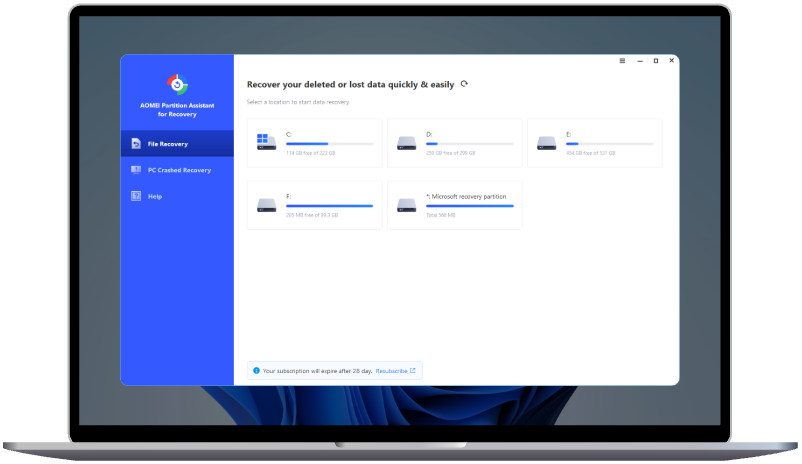How Can I Recover Microsoft Word Documents
How can I recover Microsoft Word documents? How to recover them if they are unsaved, lost, or deleted? You will learn 4 easy and effective methods in this passage.
How can I recover Microsoft Word documents?
Recovering Microsoft Word documents can be essential when files are lost due to various reasons, such as accidental deletion, software crashes, or hardware failures. Often, users find themselves in a panic when important documents suddenly disappear. However, understanding how these files are stored and backed up can be key to retrieving them.
Microsoft Word has built-in features that help with document recovery, such as AutoSave and AutoRecover. These features can save a temporary copy of your document, allowing you to retrieve it after unexpected closures or crashes. Additionally, Word often saves recovery files in specific locations, depending on your settings.
Another factor to consider is whether you have backup solutions in place, such as cloud storage or external hard drives. Cloud services like OneDrive, Google Drive, or Dropbox can automatically back up your documents, making it easier to recover lost files.
If your documents are not backed up, specialized file recovery software can sometimes retrieve lost or deleted files from your computer's hard drive. However, the success of this method can depend on various factors, such as how much time has passed since the deletion and whether new data has overwritten the space on the drive.
How to recover Microsoft Word document in 4 ways
Deleted Word documents are typically moved to the Recycle Bin, making recovery simple if the bin hasn't been emptied. However, if the file isn’t there, consider these three methods for recovering lost Word documents: third-party software, AutoRecover, Temporary Files, and File History.
Way 1. Recover lost/deleted/missing Microsoft Word document via data recovery software
The easiest way to recover a lost Word document is to apply a third-party data recovery utility. If you are looking for a reliable and easy-to-use data recovery tool, consider using AOMEI Partition Assistant for Recovery, a powerful tool designed for efficient data recovery. It offers several key advantages:
✍ Advantages of AOMEI Partition Assistant for Recovery
► Wide compatibility: Supports NTFS, FAT32, exFAT, and ReFS file systems, and works seamlessly on Windows 7, 8, 10, and 11.
► Versatile recovery: Retrieves lost or deleted data from various storage devices, including HDDs, SSDs, USB drives, and more.
► Supports multiple file types: Recovers Word documents along with Excel files, PowerPoint presentations, images, videos, audio files, emails, web pages, and compressed files.
► Comprehensive scanning: Automatically performs both quick scans and deep scans to locate all deleted data effectively.
With its user-friendly interface and robust functionality, AOMEI Partition Assistant for Recovery provides a reliable solution for recovering lost files, even in complex scenarios.
Step 1. Install and launch AOMEI Partition Assistant for Recovery. Choose the exact partition or disk where your data is lost and click Scan.
Step 2. Then, the recovery tool starts to scan and search. lt will execute the “Quickly Scan" first to find your deleted data fast, and then execute the “Deep Scan" for searching other lost data.
Step 3. Once the scan is completed, all deleted files, recycle bins and other missing files will be displayed. Please select the file you would like to recover and then click "Recover".
Step 4. Then, select a folder path to save your recovered files.
Step 5. Wait patiently for this process of recovery to end.
Way 2. Restore unsaved Word documents from AutoRecover
The AutoRecover feature in Microsoft Office automatically saves your work at set intervals. If enabled, it can help you retrieve unsaved documents.
Step 1. Navigate to the folder where unsaved files are stored. The default path is:
C:\Users\Username\AppData\Local\Microsoft\Office\UnsavedFiles
Step 2. Identify the file you want to recover and copy its name.
Step 3. Click File in the top menu.
Step 4. Select Manage Document, then choose Recover Unsaved Documents from the drop-down menu.
Step 5. Paste the copied file name into the search bar and click Open to retrieve your document.
Step 6. Go to File > Options > Save.
Step 7. Save AutoRecover information every [x] minutes.
Step 8. Keep the last autosaved version if I close without saving.
Step 9. Click OK to confirm.
Way 3. Recover not Saved Word documents from Temporary Files
Similar to AutoRecover, the AutoSave feature in Microsoft Office can also help restore lost Word documents if it was enabled beforehand.
Step 1. Launch Word and navigate to the File tab in the upper left corner.
Step 2. Click Manage Documents and select Recover Unsaved Documents from the drop-down menu.
Step 3. If the document was lost recently, it should appear in the displayed window. Open the file and click Save As from the top banner to save it to a preferred location.
AutoSave provides an additional layer of protection, ensuring your work is recoverable even in unexpected situations.
Way 4. Retrieve unsaved Word with File History
For computers running Windows 8 or later with File History enabled, you can recover lost Word documents by accessing previous versions of files and folders.
Step 1. Go to the Control Panel by pressing Win +R and typing control.
Step 2. Select File History in the System and Security section.
Step 3. Click Restore personal files to view all versions of files.
Step 4. Choose the photos you want to recover, and then click the Recover button.
Conclusion
This guide outlines four methods to recover unsaved Word documents on Windows devices. With the assistance of AOMEI Partition Assistant for Recovery, you can restore lost, unsaved, or deleted Word files, even without backup copies.
We hope these solutions help you recover your lost documents. To avoid future data loss, it’s always a good idea to create backup copies of your important Word files.

